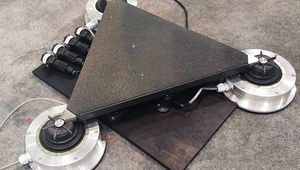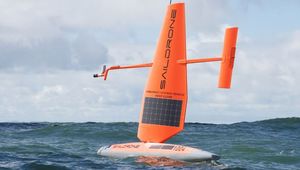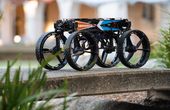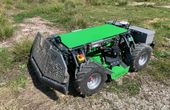Sherpa
The SherpaTT is developed in order to be a part of a controlled multi-robot team in the TransTerrA project that aims to gather samples from lunar or planetary surface exploration. It is an autonomous, hybrid wheeled-leg system hardware type rover that is characterized by its four legs with attached wheels at the end. This system allows SherpaTT to walk and drive over different complex terrain.
Technical Specifications
| Width | 240 |
| Length | 240 |
| Height | 120 |
| Lenth arm | 180 |
| Weight | 200 |
| Power supply | |
| Degrees of freedom | 30 |
| 4 | |
| 2 | |
| 6 | |
| Sensors | 1 |
| 1 | |
| 1 | |
| 1 | |
| Actuation |
Overview
It is an autonomous, hybrid wheeled-leg system hardware type rover that is characterized by its four legs with attached wheels at the end. This system allows SherpaTT to walk and drive over different complex terrain.
In order to investigate places that have environmental conditions not suitable for humans, research and resources are channeled on the development of mobile robots. These robots can provide the capability to explore and collect scientific data from a hazardous or difficult to reach location. With this, the autonomy of the robot is important as it is meant to survey the area independently without human intervention.
The goal of the project is to make a hybrid walking and driving rover with high mobility that is robust and stable in walking and climbing over irregular terrain. The collected samples of SherpaTT are handed over to the landing site and will eventually be sent back to earth for study and research.
SherpaTT System Overview
SherpaTT is fitted with an internal power supply, camera, LIDAR (Light Detection and Ranging) sensor, a force-torque sensor at each wheel, and a manipulator arm used for handling payload.
The rover is also equipped with four payload interfaces placed around the manipulator tower and one at the bottom of the body. These electro-mechanical interfaces (EMI) are used for seamless integration in transporting payloads with its other teammate robots, such as Coyote III. The EMI will also serve as an additional port for attaching additional devices or sensors in the future and for reconfiguring modular payload items appropriate for different tasks.
SherpaTT has four legs in an active suspension system that has 20 degrees of freedom altogether. The wheeled legs are able to move in a 3D workspace similar to a toroid that makes SherpaTT versatile and adaptable to different footprint patterns.
Motion Control System
The Motion Control System (MCS) serves as the bridge between the robot’s firmware and high-level controls used for navigation and autonomous functions. It is set-up to cover the control of the complex kinematics of SherpaTT.
The main command inputs are the Motion Command, Body Posture, and Footprint.
- Motion command is used to control the three-dimensional robot movements in x, y, and z, where x is forward, y is lateral and turn movements about z.
- The Body Posture commands are used to control the six degrees of freedom of the central body.
- Footprint commands are used to describe the three degrees of freedom for each leg endpoint (LEP).
Active Ground Adaptation
The MCS of SherpaTT also has a Ground Adaptation Process (GAP) that allows the robot’s wheeled legs to conform to the terrain. The GAP is fitted with modules one of which, is the Ensure Ground Contact (EGC) module that keeps the wheels to be in contact with the ground at all times. Once a leg is relieved of force acting on it, the wheels will adjust along the z-axis to close the gap.
Experiments are set up in order to test the motion control system and for validating the rover’s ground adaptation process capabilities if it were to move in an irregular terrain. The test shows that without the adaptation to the obstacle, the load will not be distributed evenly to all the legs and a single wheel may suffer from the load imbalance. With the GAP, the deviation of force for each leg has been reduced to ±50N as opposed to ±300N if it is not implemented.
Altogether, the results show that SherpaTT is a stable robot equipped to navigate and adapt to extraterrestrial landscapes. Continued field tests are still necessary though in order to cover all subsets of its system configuration to ensure robustness.
Besides its development essentially for space explorations, SherpaTT can also be used for terrestrial functions like in search and rescue, and security applications. A waterproof version of SherpaTT, SherpaUW, are also developed for marine and deep-sea exploration.
References
This paper subsumes the first experiences with the hardware of the robotic system SherpaTT. The mobile platform consists of four legs, each equipped with a wheel at its end
Official project page with more information like software on DFKI's website.










